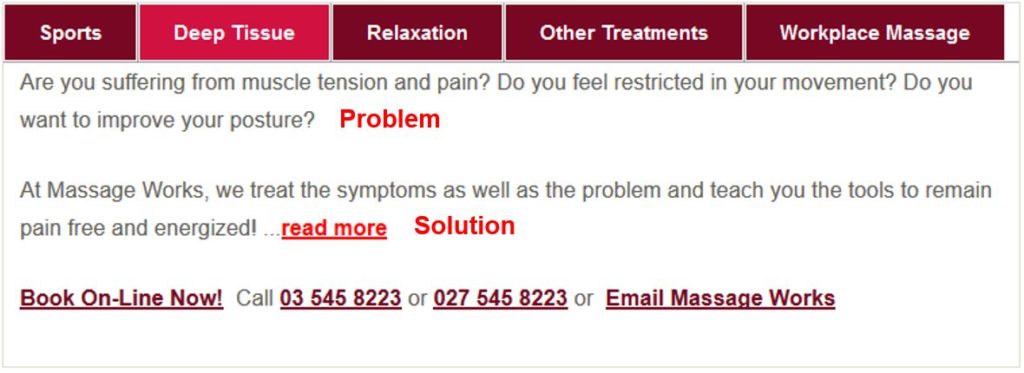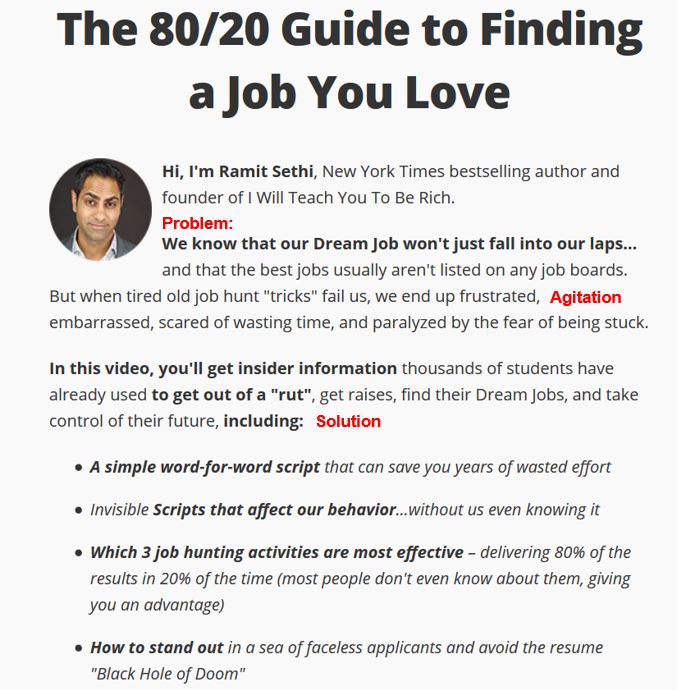You offer a valuable service, and you’re 100% certain there is a market for it. But now you need to persuade buyers of your worth.
How can you craft website content that engages prospects and closes the deal?
Effective website content comes down to several factors. So, before you put pen to paper, you need to research and plan every aspect of your site.
This includes things like…
- Mapping out your pages
- Researching your SEO keywords
- Fine tuning your message
- Targeting each page to the correct audience
Once you’ve got a solid plan, you can start thinking about writing your website content.
But where do you start?
The best place to start is by organising your messages for the most persuasive impact. You can do this is by using a copywriting framework.
Use A Copywriting Framework to Structure Your Website Content
Because only rookies write from scratch
Joanna Wiebe [1]
A copywriting framework is the organisational structure of your copy. It won’t tell you what to say (your message) or how to say it (your copy), but it will tell you in which order to say it.
Copywriting frameworks have one simple objective: to structure copy in the most persuasive way possible.
They eliminate guesswork and help you write your website content faster and with a higher likelihood of success.
Although there are many different formulas, the one I am about to share with you is the key to effective website content.
Introducing, PAS…
Problem, Agitation, Solution (PAS)
When you understand that people are more likely to act to avoid pain than to get gain, you’ll understand how powerful this formula is. (…) It may be the most reliable sales formula ever invented.
Dan Kennedy [3]
To understand the persuasive power of PAS, it’s important to understand a basic concept of human psychology: our desire to avoid pain.
Smart marketers tap into this desire and channel it onto their product or service. By reminding readers of the lurking threat of pain, PAS persuades prospects to take action and eliviate their problem.
The best way to do this is by showing them how your product or service can help them solve a problem that they’re facing.
A sidenote on ethics: When I’m talking about persuasion, I am not talking about misleading, morally questionalble, or manipulative techniques. (Although, sadly, the field of marketing is strewn with these). I am talking about helping people make decisions in their best interest by connecting the dots between their needs and your offer.
So, how does the PAS formula work?
It’s simple. First, you describe your prospects’ problem. Next, you agitate the problem from an emotional standpoint. Then you offer your solution. And, last, you show your prospect what their life will be like after they have successfully implemented your solution.
Let’s take a closer look at each step:
Problem
The first step is to find out your prospects’ primary motivator for seeking your product or service. This is the “problem” that will form the heart of your message.
It could be…
- A physical or emotional need
- An unfulfilled desire
- Fears and insecurities
- Discomfort or pain
Try to understand the problem as best you can, and then start the page by addressing the problem. This hooks your audience into your copy because they feel understood. In fact, the more accurately you can describe the problem, the more your audience will feel that you must have an answer [4].
Your aim here is to connect with your audience by showing them that you understand their needs. In the words of marketing genius Robert Collier, you want to “join the conversation that’s already taking place in their mind”
Agitation
Once you have hooked your readers by describing their problem, poke at it from different angles. Remind your readers why it’s time to shift the status quo and that they don’t have to put up with the problem any longer.
Do your research to find out what the biggest source of agitation is for your prospect around their problem.
- What is the biggest headache this problem creates?
- What are their main frustrations to do with the problem?
- What are the real-world consequences of their problem?
- What is the cost of not taking action to solve the problem?
Once you understand your readers’ biggest source of agitation, bring it to life by reflecting it back at them with vivid mental images.
This step is crucial and often overlooked in website content.
Most websites identify the problem and then present the solution. Or worse, only present the solution with no context of a problem.
The result? Their copy doesn’t connect. It doesn’t engage. It doesn’t compel. And it doesn’t sell.
Take this page, for example:

Where is the agitation?
It takes research and confidence to tap into the agitation but doing so will propel your website content to the next level.
Solution
Now that you have established the need for your product or service, it’s time to present your solution.
But don’t just tell readers about your solution. Show them the many ways in which your offer can provide relief to their problem.
The best way to do this is by zeroing in on key benefits.
A good example of the PAS formula at work is this page by Ramit Sethi

How to use PAS in Your Website Content
You can use PAS in pretty much every element of your website content.
An obvious place to use it is in your body copy, like in the example of Ramit Sethi’s page. But you can also use it in your headlines, sub-headlines, benefit boxes, and more.


Identifying Problems and Sources of Agitation
Following the PAS structure itself is simple.
The challenge most people face when writing website content is identifying the correct problems and sources of agitation.
The best way to find out what pushes your prospects’ buttons is through research. This will help you understand, empathise, and genuinely connect with your audience.
Only then, you’ll be able to “join the conversation that’s already taking place in their minds” [Robert Collier].
In your research, you’re looking for any snippets of information that give you insight into your prospects’ minds. You want their opinion.
Luckily, the internet is littered with people’s opinions. All you need to do is find the ones relevant to you.
To do this, sift through forums, blogs and social media (to name a few) and look for things your potential customers have said about all things related to your product or service.
If you sell personal training, read weight loss forums. If you sell wool, join knitting Facebook groups. If you sell web design, look at your Google reviews and those of other web designers. All these things will help you paint a clear picture of your audience.
Here’s the type of information that should make your ears perk up:
Recurring ideas and messages. Anything you see mentioned over and over by prospects.
For example, a recurring theme among weight watchers is overwhelm! “I don’t know what I’m supposed to be eating”, “There are so many diets, and I don’t know which one to do”, etc.
Pains and problems. Here, you’re looking for the pains, needs, and problems perceived by your prospects.
Going back to our diet example, this could be: “Diets are so hard to stick to”, “I can’t fit my nice clothes”, “I hate having to shop at plus-sized shops”, “My weight is impacting my mobility”, etc.
Objections. What are their objections to common solutions?
This is important because you will need to address and overcome these objections in your copy.
For example: “Diets don’t work because I always gain the weight back afterwards”, “I can’t stick to a diet because I’m too busy to count calories”
Expectations. What do they expect of a possible solution?
What do they like? Do they praise certain aspects of available solutions? What do their positive reviews focus on?
For example, you might find that people like Keto and Intermittent Fasting because they don’t have to count calories
What don’t they like? Do they moan about certain aspects of available solutions? What do their negative reviews complain about?
What have they tried to solve their problem? Chances are, your prospect has tried to solve their problem before but has failed. Find out what they have tried and, more importantly, why they failed.
In your copy, make sure to show them why your solution is different and will lead to success.
Emotional impacts of their problems. Look for any mentions of your prospects’ feelings and emotions.
How did past failure make them feel? How does living with the problem make them feel? How would it feel like to finally solve their problem?
This is where you draw your agitation from.
Once you have collected enough research data, you’ll be able to plug it into the PAS(O) formula and work it in with your message.
Where to Find Voice of Customer Data for Your Website Content
To save you from stabbing in the dark, here are some great ideas for where to start your research:
- Amazon product reviews
- Fiverr service reviews
- Yelp reviews
- Trip advisor reviews
- Other industry-specific review sites
- Customer surveys
- Other surveys
- Support tickets
- Special interest forums
- Facebook groups
- Facebook comments
- Blog posts / blog post comments
- Reddit and sub-reddits
- Quora
Wrapping up
Once you’ve got your message sorted and are ready to write your website content, hold fire. You don’t have to reinvent the wheel and write from scratch. In fact, your copy will probably be more engaging, compelling, and effective if you don’t.
Instead, why not use the PAS copywriting formula like thousands of professional copywriters?
If you use this framework right, I guarantee your website content will be far more effective than if you simply write off the cuff. And remember to include the most important piece of the puzzle – agitation!
If you have any questions, please reach out to us at office@tales.co.nz We’d love to hear from you, and we’re here to help!
References
[1] Joanna Wiebe. (2015). The Ultimate Guide to No-Pain Copywriting (or, Every Copywriting Formula Ever). Copyhackers [2] Ruth, A., & Wysocki, A. (2002). Top Sellers: Characteristics of a Superior Salesperson. Department of Food and Resource Economics, University of Florida, FL. [3] Dan Kennedy. (2011). The Ultimate Sales Letter: Attract New Customers. Boost Your Sales. Adams Media; Fourth edition (February 14, 2011) [4] Ray Edwards. How to Write Copy That Sells.If you want to build brand awareness, authority, and trust, your best bet is to start by nailing your brand story.
Whenever you are ready, there are 2 ways we can help you do that:
- Join The Storydriven Marketing Academy: Our FREE course that teaches you how to consistently nail your messaging across all brand assets
- Enquire about our Brand Storytelling Workshop: We work with you 1:1 over four guided workshop sessions to craft your storydriven brand messaging & content strategy
